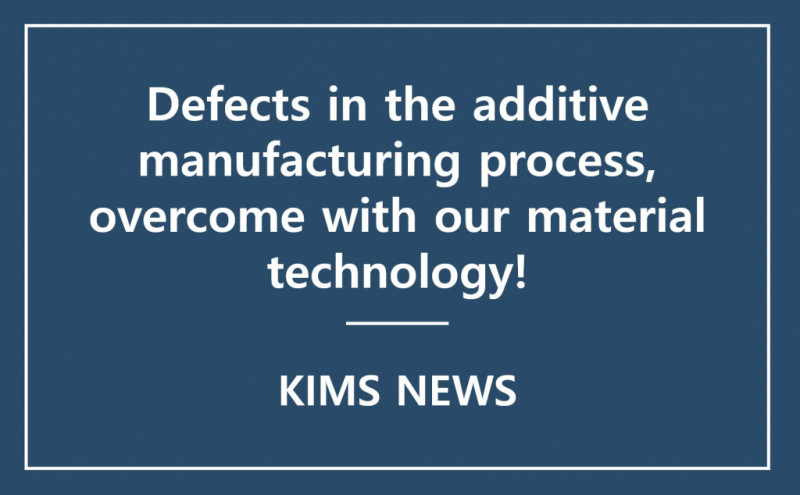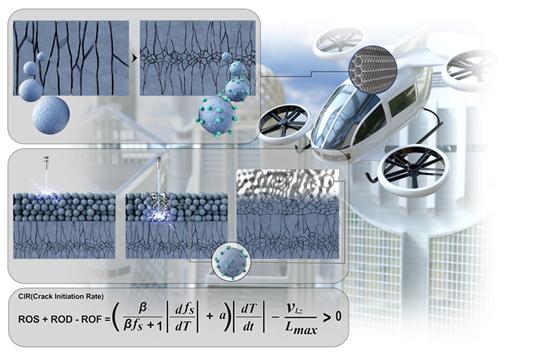R&D | KIMS localization of aluminum alloy powder technology exclusively for 3D printing and presentation of a defect prediction model during the process for the first time in the world
Page info
Date23-02-17 10:53 Hit294Link
Contents
Defects in the additive manufacturing process, are overcome with our material technology! |
A research team led by Dr. Kyung Tae Kim of the Powder Materials Division of the Korea Institute of Materials Science (KIMS), a government-funded research institute under the Ministry of Science and ICT, through a joint study with Hyundai Motor Co., Ltd. and Pohang University of Science and Technology (Professor Hyung-seop Kim), succeeded in localizing powder material manufacturing technology exclusively for 3D printing of high-strength aluminum alloy for next-generation mobility parts, and presenting the reliable numerical model to predict the problem of solidification crack behavior in advance.
Until now, because high-strength aluminum powder material technology exclusively for metal 3D printing and crack-prediction technology have been developed separately, the integrated solution for both issues was required. In addition, the conventional solidification crack behavior prediction model shows the tendency of crack generation, but it is difficult to predict the critical point of solidification crack generation, so whenever there is a change in materials and processes, the critical point had to be tested and found empirically.
The technology developed this time localized the high-strength 7000 series aluminum alloy composite powder synthesis process considering the characteristics of the laser-based additive manufacturing process, and also analytically quantified the conditions under which cracks occur during the process. Since the developed model is to predict the critical point of crack generation, it is possible to provide an optimal solution for manufacturing high-strength aluminum 3D printing parts. As this makes it possible to apply the additive manufacturing process of 7000 series aluminum alloy, which is a key material in the fields of aviation, space, and mobility, it is expected that the developed technology will be widely used in the future.
Existing 7000 series high-strength aluminum alloys were unable to be laser-based AM process due to solidification cracks severely caused by columnar grain structure. The developed technologies can produce a high-strength aluminum alloy with no cracks and twice the yield strength compared to Al-Si-based AM materials by controlling laser process conditions based on the composite powder and numerical models. It is significant in that it suggests a direction to secure economic feasibility and physical properties at the same time.
The market size of aluminum alloy powder for additive manufacturing is growing rapidly from $8.56 million in 2018 to $40.53 million in 2023 (Source: Smartech publishing, 2018). However, since high-strength aluminum alloy materials for additive manufacturing are exclusively supplied at a high price by advanced overseas companies, through this technology development, it is expected that exports of an integrated solution combining powder and process as well as import substitution effect by localization will be possible.
"This technology will serve as a model for localization of high value-added lightweight aluminum alloy powder in the metal powder material field for additive manufacturing, which currently relies entirely on imports,” said Kyung Tae Kim, research director at the KIMS. “For the low-cost commercialization of the developed materials technology in the future, close collaboration with metal 3D printing demand company and powder production industry is required,” he said.
This research achievement was carried out through the principal projects of the Korea Institute of Materials Science, the consignment project of Hyundai Motor Co., Ltd., and the metal additive manufacturing material parts research center project of Pohang University of Science and Technology with the support of the Ministry of Science and ICT. In addition, the results of the study were published on January 25 in Additive Manufacturing (IF: 11.31), the world’s No. 1 academic journal in the field of 3D printing (first author: Researcher Jungho Choe from the KIMS). Currently, the research team is conducting follow-up research to enhance 3D-printed aluminum alloy properties and to secure the original technology for mass-manufacturing exclusive aluminum powder through continuous joint research with Hyundai Motor Co., Ltd. and Pohang University of Science and Technology.


